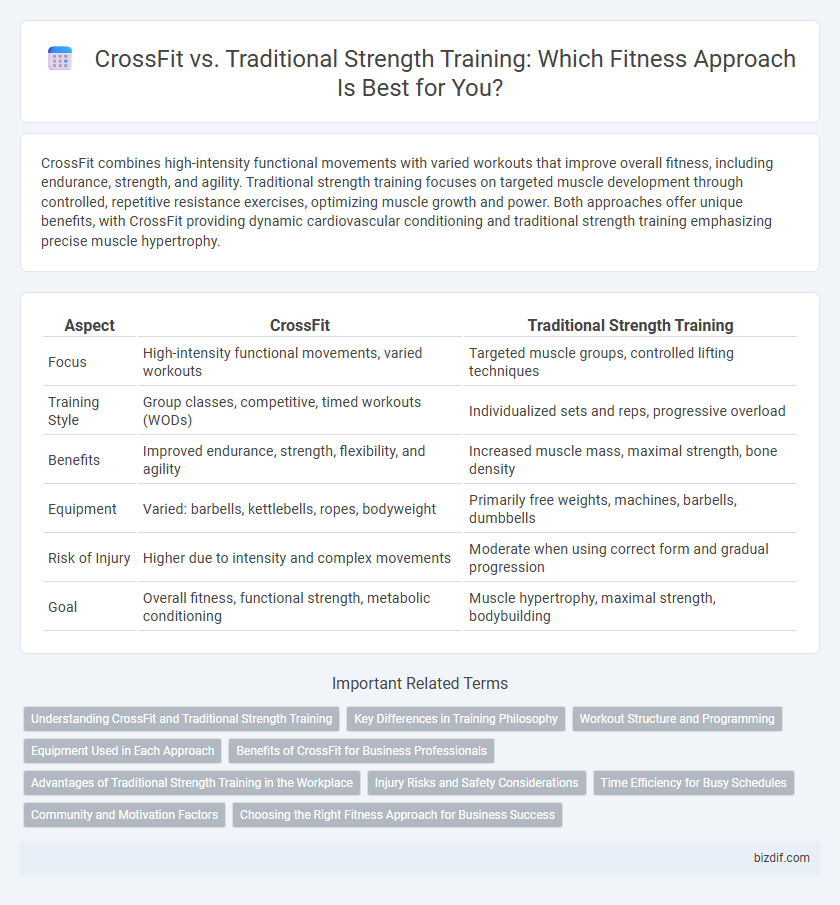CrossFit combines high-intensity functional movements with varied workouts that improve overall fitness, including endurance, strength, and agility. Traditional strength training focuses on targeted muscle development through controlled, repetitive resistance exercises, optimizing muscle growth and power. Both approaches offer unique benefits, with CrossFit providing dynamic cardiovascular conditioning and traditional strength training emphasizing precise muscle hypertrophy.
Table of Comparison
| Aspect | CrossFit | Traditional Strength Training |
|---|---|---|
| Focus | High-intensity functional movements, varied workouts | Targeted muscle groups, controlled lifting techniques |
| Training Style | Group classes, competitive, timed workouts (WODs) | Individualized sets and reps, progressive overload |
| Benefits | Improved endurance, strength, flexibility, and agility | Increased muscle mass, maximal strength, bone density |
| Equipment | Varied: barbells, kettlebells, ropes, bodyweight | Primarily free weights, machines, barbells, dumbbells |
| Risk of Injury | Higher due to intensity and complex movements | Moderate when using correct form and gradual progression |
| Goal | Overall fitness, functional strength, metabolic conditioning | Muscle hypertrophy, maximal strength, bodybuilding |
Understanding CrossFit and Traditional Strength Training
CrossFit combines high-intensity functional movements with varied workouts to improve overall fitness, strength, and endurance through scalable exercises like Olympic lifts and metabolic conditioning. Traditional strength training focuses on controlled, systematic resistance workouts targeting specific muscle groups using free weights or machines to build muscle mass and strength progressively. Understanding these approaches helps tailor fitness goals by emphasizing either general physical preparedness through varied movements or focused muscle hypertrophy and maximal strength gains.
Key Differences in Training Philosophy
CrossFit emphasizes functional movements performed at high intensity, combining elements of weightlifting, cardio, and gymnastics to enhance overall fitness and scalability for various skill levels. Traditional strength training focuses on isolated muscle groups using heavy weights with controlled repetitions to maximize muscle hypertrophy and strength gains. CrossFit promotes varied workouts and community-driven competition, while traditional strength training prioritizes progressive overload and technique refinement.
Workout Structure and Programming
CrossFit workouts feature varied, high-intensity sessions combining weightlifting, cardio, and gymnastics, programmed daily to enhance overall fitness. Traditional strength training relies on structured routines focusing on specific muscle groups with fixed sets and reps, designed to progressively increase muscle strength and size. CrossFit's constantly varied programming promotes functional movements, while traditional methods emphasize targeted muscle development through consistent load progression.
Equipment Used in Each Approach
CrossFit training utilizes a diverse range of equipment including barbells, kettlebells, pull-up rigs, rowing machines, jump ropes, and medicine balls to promote functional movements and high-intensity workouts. Traditional strength training primarily relies on free weights such as dumbbells and barbells, as well as resistance machines designed to target specific muscle groups for controlled, progressive overload. The varied equipment in CrossFit supports multi-modal fitness by combining cardiovascular, strength, and endurance elements, whereas traditional strength training emphasizes isolated muscle development through specialized apparatus.
Benefits of CrossFit for Business Professionals
CrossFit offers business professionals a high-intensity, time-efficient workout that improves cardiovascular health, strength, and mental resilience, essential for managing work stress and demanding schedules. Its varied, functional movements enhance overall mobility and reduce injury risk, promoting sustained productivity in professional environments. The supportive CrossFit community also fosters networking opportunities and motivation, contributing to greater consistency in fitness routines.
Advantages of Traditional Strength Training in the Workplace
Traditional strength training improves muscular endurance and core stability, reducing the risk of common workplace injuries such as back pain and repetitive strain. It enhances functional strength, enabling employees to perform physically demanding tasks more efficiently and with improved posture. Regular strength training increases metabolic rate and energy levels, contributing to better overall productivity and reduced absenteeism in the workplace.
Injury Risks and Safety Considerations
CrossFit combines high-intensity workouts with varied functional movements, which can increase injury risks if performed without proper technique or supervision, especially during complex lifts like Olympic weightlifting. Traditional strength training generally emphasizes controlled, repetitive movements with lighter to moderate weights, reducing the likelihood of acute injuries but posing risks of overuse injuries if progression is too rapid or form deteriorates. Ensuring proper coaching, gradual intensity increases, and adequate recovery are essential safety considerations for minimizing injury in both CrossFit and traditional strength training.
Time Efficiency for Busy Schedules
CrossFit workouts combine high-intensity interval training with functional movements that deliver a full-body workout in 20 to 30 minutes, making it ideal for busy schedules. Traditional strength training often requires longer sessions focused on individual muscle groups, typically lasting 45 to 60 minutes. CrossFit's varied and condensed routines maximize calorie burn and muscle engagement in less time compared to conventional strength programs.
Community and Motivation Factors
CrossFit fosters a strong community atmosphere that boosts motivation through group workouts and shared challenges, creating accountability and camaraderie. Traditional strength training often emphasizes individual progress, which can lead to less social interaction but allows personalized focus on technique and goals. The group dynamics in CrossFit significantly enhance commitment and consistency compared to the solitary nature of traditional strength routines.
Choosing the Right Fitness Approach for Business Success
CrossFit offers high-intensity, varied workouts that build functional strength and cardiovascular endurance, appealing to clients seeking dynamic and community-driven fitness experiences. Traditional strength training focuses on systematic muscle building through controlled, progressive overload, attracting individuals aiming for targeted strength gains and injury prevention. Selecting the right fitness approach for business success depends on understanding client demographics, goals, and preferences to tailor programs that maximize engagement and retention.
CrossFit vs Traditional Strength Training Infographic

 bizdif.com
bizdif.com